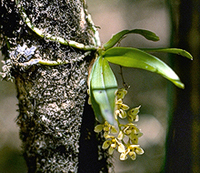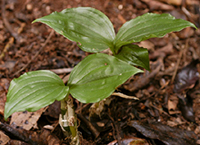

  |
The Australian flora currently contains about 1700 species of Orchidaceae. Of these about 1250 species have been named and about another 450 are known but await formal botanical description. A further 5 exotic species have become naturalised. Of the named orchid species about 95% are endemic to Australia.
Impact of recent research: Detailed studies into various aspects of Australian Orchidaceae, especially taxonomy, began in the 1990s. The impact of taxonomic research from this time is apparent when one considers that in 1988 the Australian orchid flora consisted of about 680 named species.
Influence of growth habit: Terrestrial species dominate Australian orchids, comprising about 82% of the named orchid flora (or 1040 species), whereas only 18% of the named orchids (or 243 species) are epiphytes or lithophytes. The terrestrial habit becomes even more dominant when the number of unnamed species is taken into account.
Generic studies: The interpretation of the rank of genus is one of the most contentious subjects in botany and the controversy is applicable in Australian Orchidaceae. Many botanists take a conservative approach to the rank and are comfortable with the concept of large genera containing distinctive natural groups with questionable relationships to each other, assigning these groups to some infrageneric rank such as subgenus or section. Other botanists consider that significant natural groups are better recognised as distinct genera, despite the antagonism that these changes may create within the botanical and horticultural community. In 1988 it was generally considered that the Australian orchid flora was distributed in 107 genera. This number has increased dramatically and in 2005 some 192 genera are involved, including 5 named hybrid genera. Of these 115 genera are terrestrials and 77 genera are epiphytic or lithophytic.
  |
Impact of molecular studies: Traditional taxonomic studies are based on morphology, particularly floral morphology. This has often lead to false conclusions within the large family Orchidaceae because of the significant impact of selection pressures on floral development exserted by external influences, particularly pollinators. These external selection pressures have lead to a higher degree of conservatism in floral development than is found in other plant families, with many unrelated orchid groups having similar general morphology due presumably to the impact of convergence.
Recent studies analysing molecular data embedded in the DNA of cell organs such as chloroplasts and the cell nucleus have provided additional genetic information on ancestral relationships that are not readily apparent from morphological studies. Research of this type has been carried out on many groups of orchids in different countries resulting in an increased knowledge of phylogenetic relationships and providing support for reclassification of groups within the family, resulting in many name changes.
Significance of vegetative morphology: A significant common theme that has emerged from several molecular studies by various researchers in different countries on different orchid groups has been the taxonomic influence of vegetative characters compared with floral characters. Traditionally vegetative characters have been generally regarded as taxonomically uninformative, with most emphasis in phenetic studies being placed on floral features, but the significance of growth habit and leaf features has been shown clearly in these molecular studies, and should be useful in this key.